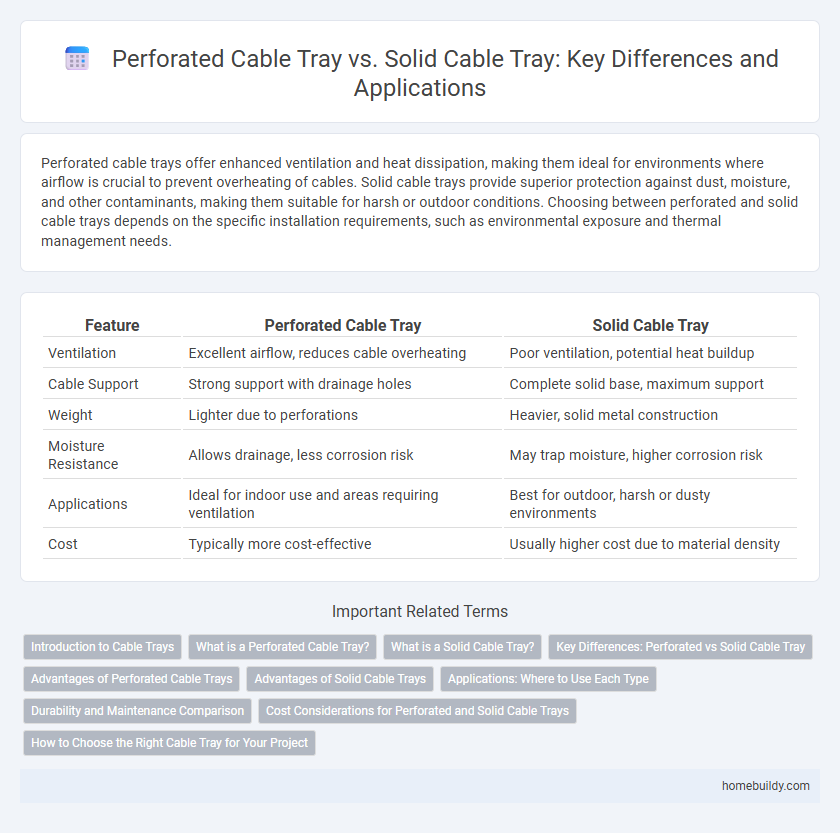Perforated cable trays offer enhanced ventilation and heat dissipation, making them ideal for environments where airflow is crucial to prevent overheating of cables. Solid cable trays provide superior protection against dust, moisture, and other contaminants, making them suitable for harsh or outdoor conditions. Choosing between perforated and solid cable trays depends on the specific installation requirements, such as environmental exposure and thermal management needs.
Table of Comparison
| Feature | Perforated Cable Tray | Solid Cable Tray |
|---|---|---|
| Ventilation | Excellent airflow, reduces cable overheating | Poor ventilation, potential heat buildup |
| Cable Support | Strong support with drainage holes | Complete solid base, maximum support |
| Weight | Lighter due to perforations | Heavier, solid metal construction |
| Moisture Resistance | Allows drainage, less corrosion risk | May trap moisture, higher corrosion risk |
| Applications | Ideal for indoor use and areas requiring ventilation | Best for outdoor, harsh or dusty environments |
| Cost | Typically more cost-effective | Usually higher cost due to material density |
Introduction to Cable Trays
Cable trays provide structured support and protection for electrical cables in various industrial and commercial installations. Perforated cable trays offer enhanced ventilation and heat dissipation through multiple holes, reducing the risk of overheating in high-power applications. Solid cable trays provide maximum protection against dust, debris, and physical damage, making them ideal for environments requiring stringent cable safeguarding.
What is a Perforated Cable Tray?
A perforated cable tray features a series of evenly spaced holes or slots throughout its surface, allowing for enhanced ventilation and heat dissipation for electrical cables. This design helps prevent moisture buildup and facilitates easier cable management by providing multiple points for cable tie-downs and attachments. Commonly used in industrial and commercial wiring systems, perforated cable trays offer improved airflow compared to solid cable trays, making them ideal for environments requiring heat regulation and cable integrity.
What is a Solid Cable Tray?
A solid cable tray is a type of cable management system featuring a continuous, flat bottom without any perforations or openings, designed to provide maximum support and protection for cables. This tray is ideal for environments requiring high levels of dust, moisture, or chemical resistance, as it prevents contaminants from reaching the cables. Solid cable trays are commonly used in industrial settings, clean rooms, and outdoor installations where cable integrity and environmental protection are critical.
Key Differences: Perforated vs Solid Cable Tray
Perforated cable trays feature a series of holes or slots that enhance airflow and allow for easy cable fastening, reducing heat buildup and improving ventilation. Solid cable trays provide maximum protection against dust, debris, and electromagnetic interference, making them suitable for environments requiring high protection and minimal exposure. The choice between perforated and solid cable trays depends on factors such as ventilation needs, environmental conditions, and the level of cable protection required.
Advantages of Perforated Cable Trays
Perforated cable trays offer superior ventilation, reducing heat buildup around electrical cables and enhancing overall system safety. Their design facilitates easier cable management and installation by allowing cables to be secured at multiple points, preventing slippage and damage. Additionally, perforated trays are lighter than solid trays, which simplifies handling and reduces structural load on support systems.
Advantages of Solid Cable Trays
Solid cable trays provide superior protection against dust, moisture, and physical damage, making them ideal for harsh or outdoor environments. They offer enhanced load-bearing capacity and structural strength compared to perforated trays, supporting heavier cable installations. Solid trays also minimize electromagnetic interference, ensuring better performance of sensitive electronic cables.
Applications: Where to Use Each Type
Perforated cable trays excel in environments requiring enhanced ventilation and heat dissipation, making them ideal for industrial settings with high electrical loads or areas prone to moisture. Solid cable trays provide superior protection against dust, debris, and physical damage, suitable for clean rooms, offices, and outdoor installations where cable shielding is essential. Choosing between perforated and solid trays depends on factors such as environmental exposure, airflow requirements, and the need for cable protection.
Durability and Maintenance Comparison
Perforated cable trays provide superior ventilation, reducing heat buildup and minimizing corrosion, which enhances overall durability in humid or corrosive environments. Solid cable trays offer robust protection against physical damage and are easier to clean, resulting in lower maintenance efforts in dusty or debris-prone locations. Choosing between perforated and solid cable trays depends on balancing the need for airflow and heat dissipation against physical protection and ease of maintenance.
Cost Considerations for Perforated and Solid Cable Trays
Perforated cable trays generally cost more upfront due to manufacturing complexity and material usage but offer better ventilation, reducing heat buildup and potentially lowering maintenance expenses over time. Solid cable trays are typically less expensive initially and provide superior protection against dust and moisture, which can decrease the frequency of cable replacements in harsh environments. Evaluating total lifecycle costs, including installation, maintenance, and environmental factors, is essential when choosing between perforated and solid cable trays for cost-effective cable management.
How to Choose the Right Cable Tray for Your Project
Perforated cable trays provide excellent ventilation and heat dissipation, making them ideal for electrical installations that generate significant heat or require moisture drainage. Solid cable trays offer superior protection against dust, debris, and mechanical damage, suitable for environments with high contamination or physical hazards. Evaluating environmental conditions, load requirements, and maintenance needs ensures selecting the right cable tray type to optimize safety and performance in your project.
Perforated cable tray vs solid cable tray Infographic

 homebuildy.com
homebuildy.com